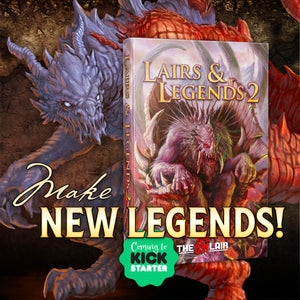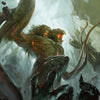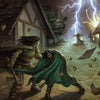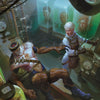How to Create a D&D Mystery Adventure
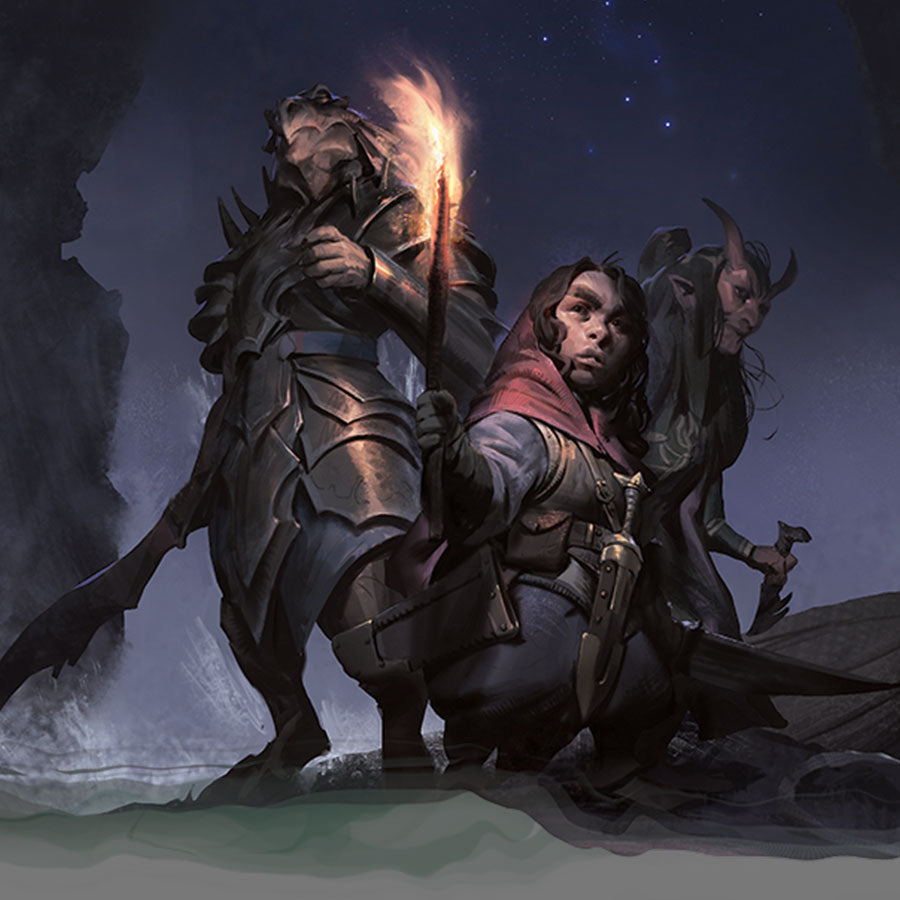
By Luke Hart
You ever play in a mystery adventure where everything feels like it should be fun—but it’s not? The clues are there, the setup seems clever, there’s a spooky old manor or a murdered noble or a missing magical artifact, and somehow you still spend three hours circling the same five rooms arguing over whether the dog counts as a suspect.
That’s because writing a good mystery in D&D is hard. Like, actually hard. It’s not just about throwing clues at your players and hoping they Sherlock their way through it. There’s a delicate balance between revealing just enough and holding back the right things, between giving your players agency and still steering the story toward a satisfying conclusion.
Sp. today we’re talking about 11 mistakes game masters often make with mystery adventures and what we should do instead.
By the way, if you're looking for a low level pre-made adventure module for your D&D 5e game, I highly recommend Into the Fey. It's designed for levels 1 to 5, features tricksy fey and their sly schemes, and contains everything you need to play!
Watch or listen to this article by clicking the video below.
Mystery Mistake #1: Starting with a Boring Premise
A noble’s been murdered. A gemstone’s gone missing. There’s a scream in the night and a trail of muddy footprints. Sound familiar? These are the kind of mystery hooks that feel like they should work—but fall flat at the table because they’re just not that interesting. Imagine a game where the central mystery is “who stole the baker’s pie?” And yeah, that’s meant to be lighthearted, but even in a silly game, no one is probably going to care because there is no tension, no stakes, no reason for characters to want to solve it beyond, “the DM says this is the plot.”
If your core mystery isn’t engaging, it doesn’t matter how clever the clues are or how well-placed the red herrings might be—because no one’s going to care enough to follow them.
So start with a hook that raises eyebrows. A missing town that’s still physically there. A noble who was murdered... twice. A victim who wanted to disappear. Mystery is about curiosity—and if your hook doesn’t spark it, nothing else will.
Mistake #2: Making It Up As You Go
One time, I asked a game master who the killer was halfway through a murder mystery adventure, and they said, “Oh, I haven’t decided yet.” That might sound clever—keep it flexible, adapt to player choices, let the story be organic. But it never works. What actually happens is the GM leaves behind a trail of random, conflicting clues, then just picks a suspect at the end and de facto retcons everything to make it fit. And your players? They’ll know. Trust me, they’ll know.
A great mystery starts with the answer. Who did it, how they did it, and why they did it. You need to know the entire crime scene in reverse. Because when players ask weird questions or explore in unpredictable ways, you can improvise confidently—without accidentally spoiling the whole thing or creating a plot hole the size of a gelatinous cube.
And just as importantly, the culprit’s motivation needs to make sense. The reveal should feel inevitable in hindsight—not like you pulled it out of a hat. Don’t fake it. Know it.
Mistake #3: Plotting Forward Instead of Backward
When most DMs write a mystery, they start at the beginning: “Okay, there’s a murder at the tavern, the butler’s nervous, and the duke has a weird alibi…” And that’s how you end up with three hours of meandering investigation and a confrontation that fizzles out with a shrug.
Instead, try this: plan the ending first. Imagine the final confrontation—what truth is revealed leading up to it—and plan the web of clues starting backwards from the end of the adventure to ensure they flow correctly in order. Ask questions like what would the players need to learn to get there? What’s the key piece of evidence that points to the killer? Where do they find it? And what misleading clues might they uncover before that, so the twist hits right when they’re sure they’ve cracked it?
A good mystery twists the knife after the players have made their assumptions. Reveal the truth when it hurts. Betray a trusted ally. Kill a suspect the players were just starting to believe. Also, let the clues fall out of order a bit, forcing the players to assemble them like a puzzle. That’s how you build a mystery worth solving.
Mistake #4: Writing Boring, One-Note Suspects
In a bad mystery, the suspects are walking cardboard cutouts. The shady merchant, the angry noble, the quiet stablehand. One of them has a motive. The rest are just there for window dressing.
That’s not a mystery—that’s a guessing game.
Instead, treat every suspect like they could be the culprit. Give them all solid motives—reasons that make sense for them to want the victim gone. Don’t just say, “He hated the victim.” Why? Did the victim ruin his family? Was there a secret affair? Make it juicy.
Then, give each suspect a secret—something they don’t want the players to discover. Maybe it has nothing to do with the mystery. Maybe they’re lying to protect someone else. But now they’re acting shady, and the players will pick up on it. Also, give them a good reason—in their opinion—for perhaps revealing the secret.
Next, build connections. Suspects should have ties to each other. Love, hate, rivalry, debt. That web is what turns your mystery from a checklist into a drama.
And finally? Even if someone knows the truth, they should sound suspicious or unreliable when they tell it. No suspect has all the facts. That’s how you keep your players doubting everything.
Mistake #5: Building Locations That Go Nowhere
You’ve probably seen this one before: the players investigate a location, find a clue, go to the next spot, find another clue, go to the next, and so on in a straight line. That’s not a mystery—that’s a breadcrumb trail.
Great mystery adventures need investigation. And investigation means options. At every location, give players multiple clues—ideally three. And those clues? They should point in different directions. Maybe one clue leads to a shady temple. Another to a suspicious barmaid. A third back to an earlier location, recontextualizing what they missed.
If a location only points to one place, the players are on rails. If every location branches out, now they’re making decisions, drawing connections, and actually doing the work of solving a mystery.
Include at least one or two red herrings throughout the adventure, too. And let the characters pursue them—but be prepared to present obvious dead-ends if they start to get too far off track or the “ticking clock” is running out.
Also: don’t repeat yourself; avoid repetition in how the clues are discovered. Some clues can be found with Investigation. Some from talking to NPCs. Some from magic. Variety keeps the table engaged.
And always prep your descriptions ahead of time. Forgetting a vital detail can derail the entire mystery if it results in players missing important details or clues the must uncover.
Mistake #6: Letting the Mystery Sit Still
One of the biggest problems in bad mystery adventures? Nothing changes. The players investigate, find some clues, and... the world just waits patiently for them to figure it all out. That’s not a mystery—it’s a museum exhibit.
A good mystery moves. The longer the players wait, the more the situation shifts. The culprit starts sweating—maybe they destroy evidence, try to pin it on someone else, or eliminate a witness. NPCs respond to what the party is doing. Rumors change. Lies evolve. People get nervous.
And if things start to feel comfortable? Change the tone. Drop a new body. Introduce a rival investigator. Have a key witness vanish. Keep the players guessing not just about what happened, but about what’s happening right now.
Every new clue, every piece of the puzzle, should raise more questions or reveal something unexpected. Even answers can be used to hook the players deeper—especially when they flip what the players thought they knew.
Because a mystery isn’t a puzzle. It’s a story. And stories change.
Mistake #7: Taking Away Player Agency
The moment your players feel like they’re being dragged through your mystery instead of uncovering it themselves, you’ve lost them. Mysteries work best when players feel like the story is unfolding because of their choices—not in spite of them.
So yes, plan. Know your mystery, your suspects, your locations—inside and out. But be ready to pivot. If they latch onto a red herring and won’t let it go, don’t just shut them down—find a way to make that path meaningful and steer them gently back toward the truth without railroading them.
And if they reach the wrong conclusion through no fault of yours? Let them fail. Let the villain get away. Let the consequences play out. Just make sure those consequences make sense, and don’t punish them unfairly. They’re already going to feel the sting.
Design your mystery so there’s no “one true path.” Use branching clues that point in multiple directions. Let them piece things together in their own way. Reward intuition. Let them surprise you. That’s when a mystery feels real.
Mistake #8: Dumping Too Much Info at Once (or Not Enough)
Mystery is about tension. And tension lives in the space between what the players know and what they think they know. If you dump all your clues too quickly—or worse, hide everything behind locked doors—they’ll either solve it in an hour or get frustrated and give up.
Control the flow of information. Reveal just enough to keep them chasing the trail, but not enough to let them solve it too early. And don’t hold back what they’ve earned—just layer it. Think of it like painting a wall: one coat at a time.
Let witnesses lie. Let clues be partial or cryptic. Let technology and spells point toward the truth but never hand it over. Every answer should spark more questions.
Use scene cuts and shifts in tone. Change perspectives. Let the players stew in their own theories—and then twist the knife with a new clue. If they almost solve it but pull away at the last second? Great. That’s suspense. Validate their wildest guesses just enough to keep the paranoia burning.
Mistake #9: Letting the Mystery Drag On Forever
A mystery without urgency is just a puzzle in a locked room. And that’s fine… if you want your players sipping tea and rolling Investigation checks for the next six hours. But if you want tension—real, seat-squirming tension—you need a ticking clock.
Urgency adds stakes. It forces decisions. It makes the players nervous that they’re running out of time—which, of course, they are. Maybe the murderer strikes again. Maybe the suspect skips town. Maybe the magical wards keeping a demon locked away are starting to crack. Whatever it is, make sure there’s pressure.
If combat happens mid-investigation, keep it fast. Don’t slow the game down with three-hour slugfests unless it’s absolutely crucial. Every round should feel like it’s eating up precious time.
And when things start to stall—when the players begin to waffle or argue over theories—that’s your cue to drop the next event. A scream. A fire. A missing NPC. Keep the momentum up. A mystery isn’t just about finding the answer. It’s about racing to find it before it’s too late.
Mistake #10: Fumbling the Landing
There is nothing worse than slogging through a long, complex mystery… only for the ending to be a massive letdown. A good mystery needs a satisfying resolution. That means it needs to feel earned.
If the culprit is someone the players never met, or the murder weapon was never mentioned, or the twist comes out of nowhere with no buildup, that’s not a satisfying payoff—it’s a narrative sucker punch. The ending should make everything click into place. The players should be able to look back and realize, “Ohhh, that’s what that meant!”
Even if they got some things wrong, the story should still make sense in hindsight. Their choices, their failures, their successes—all of that should have mattered. Otherwise, why bother solving the mystery at all?
This is the moment where your players stop being adventurers and start feeling like actual detectives. Give them that win. Don’t yank the answer out of a hat. Tie it all together. Because the ending is what they’ll remember most.
Mistake #11: Ignoring the Power of Props
Want to instantly elevate your mystery game? Use props. One of the biggest missed opportunities in mystery adventures is relying solely on narration when you could be handing your players something tangible.
A torn journal page. A bloodstained map. A cryptic note scrawled in a trembling hand. Even a sketch of a family crest on an old napkin. These don’t have to be elaborate—just a little effort goes a long way. It’s not about your artistic skill; it’s about giving your players something real to hold, study, pass around, and maybe even argue over.
Props make clues feel weighty. They anchor abstract ideas in something physical. And they immediately pull players deeper into the story, because now the mystery isn’t just happening in their heads—it’s on the table in front of them.
So don’t skip the handouts. They’re not just set dressing. They’re part of the puzzle. And they just might be the thing your players talk about for weeks after the game ends.
Confront Devious Fey and Their Tricksy Plots!
For years, the fey creatures inhabiting Pelview Grove to the north and Pelfell Bog to the east have not been a source of trouble, though perhaps they were a shade too mischievous at times. That has now changed.
Beset on all sides by a variety of issues -- childish pranks gone wild, dwarves forced out of their own brewery, and farmers missing -- the Aeredale guard is looking for help from local adventuring parties to set things right.
For those brave souls who accept the call to adventure, it'll be time to go into the fey.
If you’re looking to start up a new 5e campaign or reboot your current one, Into the Fey may be exactly what you need. Designed for levels 1 to 5, Into the Fey contains everything you need to start playing:
- Eleven fey-themed adventures for level 1 to 5 adventuring parties
- Over 40 new fey monsters
- The fully fleshed-out town of Aeredale
- Maps of Aeredale, the surrounding region, and the Fey Plane
- Player handouts
- Hag potion system
- 15 new fey magic items
- JPG image files of all Into the Fey adventure maps, including GM versions and gridded/non-gridded player versions
- JPG images files of all Into the Fey world maps
- Digital tokens of Into the Fey NPCs and monsters
Pick up the Into the Fey Ultimate Bundle to get the hardcover, the PDF, digital maps, and digital tokens.
Starting a new campaign can be tons of work; let Into the Fey do some of the heavy lifting for you!
-
Posted in
Game Master How-To Articles



